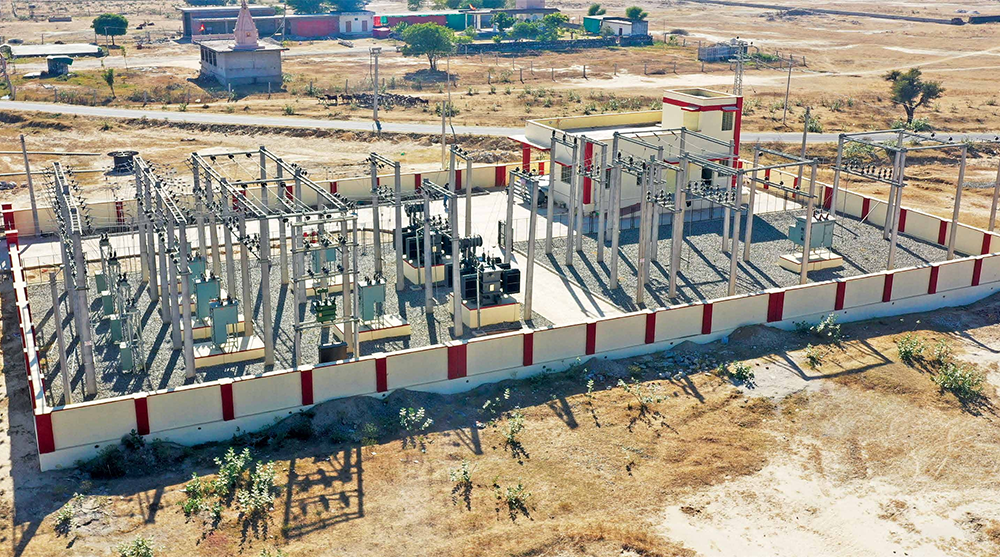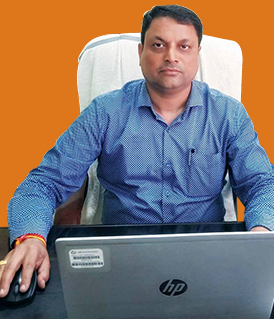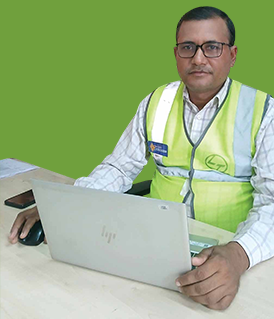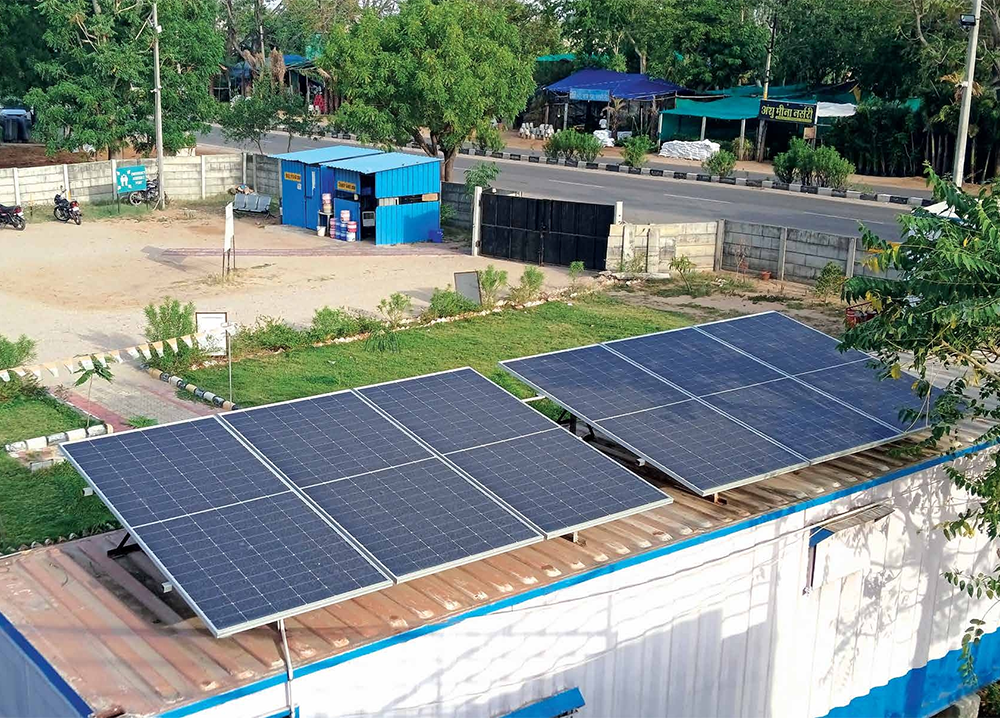When lives are at stake, safety is an imperative
RDSS Project, Jaipur

33/11 kV New GSS
Project Manager Sandeep Amin, at PT&D’s RDSS project, is not just another project manager ticking off deadlines. He and his team are on a mission to give expression to the Government of India’s Revamped Distribution Sector Scheme (RDSS), launched in July 2021, and deliver on a promise of providing quality, reliable, and affordable power to the citizens of Jaipur in Rajasthan. Being implemented for the Jaipur Vidyut Vitaran Nigam Limited (JVVNL), the team’s mandate is to build five new 33/11 kV substations, bifurcate the overloaded 33 kV & 11 kV feeders, implement a High Voltage Distribution System (HVDS) to reduce the LT network, replace vulnerable cables in theft-prone areas, segregate the agriculture & non-agriculture feeders, and ensure uninterrupted power to the residents.
Beyond the blueprints
With a 400+ workforce including employees, workers, & subcontractor personnel, and having to oversee work across numerous districts covering an area of 11,000 sq km, Sandeep and his EHS In-charge, Brajesh Kumar Pandey, saw wisdom in enforcing a stringent EHS Management System. “We have adopted a holistic EHS approach that encompasses cross–business unit (BU) EHS audits, internal evaluations, and surprise inspections carried out across diverse operational sectors, in addition to weekly walkdowns and committee assemblies with representatives from both the project team and subcontractors to instil proactive risk management practices,” explains Sandeep.
![]()
We have adopted a holistic EHS approach that encompasses cross-BU EHS audits, internal evaluations, and surprise inspections carried out across diverse operational sectors to instil proactive risk management practices.
Sandeep Amin
Project Manager
![]()

Their challenges were many. “Some days, we reach sites flooded with kneedeep water,” shares Brajesh, “and on others, it’s either unbearable heat or biting cold. But the real challenges often come without warning – an agitated farmer, a last-minute feeder reroute, or a surprise thunderstorm.”
For a team navigating both nature and neighbourhoods, safety is not an accessory; it is an armour. And so, they built a system that could think, act, and adapt. From Helmet-Mounted Induction Testers (HMITs) to digital pre-task planning tools on the SHEILD app, every risk has a response.
A critical activity is the shutdown, for which lines are surveyed, diagrams drawn, and approvals passed through a rigorous digital process. The groundwork for every shutdown begins with a survey – a careful walk of the line by a site engineer to identify exactly which feeder needs deactivation. What follows is the creation of a Pre-Task Plan (PTP) – a precise sketch of the live electrical circuits in the work zone, uploaded to SHEILD a full 60 hours before execution. Thereafter, a well-orchestrated sequence begins. District In-charges physically verify the locations and cross-check circuit details, and then the plan moves to the EHS Officer, who must approve it 12 hours prior to execution, ensuring no stone is left unturned.

3 Phase Distribution Transformer

11 kV works on PCC pole

33 kV works on Lattice Tower

Safety Park with Public Announcement System
Before the first tool touches fire
In the team’s multiple layers of protection prior to commencing work, the first is Positive Isolation, to ensure that the power feeding the line is disconnected right from its source. Each isolation point is locked and tagged – part of the Lockout and Tagout (LOTO) procedure to prevent unauthorized energization and obtain a line clearance permit from the competent authority of the state electricity board (JVVNL). Power status is then verified using HMITs after shutdown to ensure that the line is completely de-energized and discharge rods are installed on both sides of the battery limit to prevent feedback power sources. Finally, a Permit-to-Work (PTW) system is implemented between the site engineer and the gang leader before execution begins. “That we have successfully managed 564 shutdowns using a robust OTP system through the SHEILD app is proof that our system works. We ensure it does, for lives depend on it,” says Sandeep, meaning business.
Another capital technology intervention is the RFID-based fuel dispensing unit that prevents unauthorized access and fuel theft. “By switching to digital systems for managing inventory, vehicles, and tags, we eliminate human error and expedite data entry,” remarks Brajesh. The system ensures that fuel is dispensed only to authorized vehicles and can be monitored to ensure that the exact amount of fuel is dispensed.
Harnessing more than power
While live wires pose the biggest visible risks, another invisible hazard always looms above: working at height. “Before personnel climb, we test their balance, awareness, and whether they are fit enough for the task,” points out Brajesh. “We don’t let anyone just strap on a harness and go up. We educate them – not just on safety but on self-worth.” New joiners at the site undergo vertigo tests; full-body harness demonstrations are not just technical, they are emotional – a way to tell every worker, “We value your life.”
To beat the vastness of the site, offices have been set up closer to work zones, reducing travel time and enabling quicker supervision.
![]()
Before personnel climb, we test their balance, awareness, and whether they are fit enough for the task. We don’t let anyone just strap on a harness and go up. We educate them – not just on safety but on self-worth.
Brajesh Kumar Pandey
EHS In-charge
![]()

Ever ready to act
When executing a project of such magnitude and complexity, it is imperative for the project team to be in a state of emergency preparedness to preserve life, property, and environment from the consequences of any emergency arising at the workplace. This is by systematically coordinating with different stakeholders to arrest escalation of emergencies, evacuating personnel within or outside the workplace where necessary and rehabilitating them, restoring normal site operations with minimum loss of time and installing a Public Announcement System at store for repeated announcements of safety precautions & response in any kind of emergency.
Mission Zero Harm: More than just a slogan
There are numbers, and then there are stories behind them: 0.92 million safe manhours clocked since inception speak louder than words. For Brajesh, a matter of even greater pride is the project’s flawless performance across various audits, including 2 internal EHS audits, 2 cross-BU EHS audits, and 2 surprise audits, all of which yielded no NonConformance Reports (NCRs) or major observations. More than 10,500 unsafe acts corrected, 488 near-miss incidents logged, and no major injuries since the project’s inception are not mere statistics. They are proof of a system that works – because people believe in it.
“It is an honour to continuously receive ‘Excellent’ feedback from our customers every quarter of each fiscal year as well as three Safety Appreciation Certificates from higher authorities of the JVVNL team,” shares a delighted Brajesh. “Our audit scores consistently surpass 85% in all internal assessments, and we have maintained levels exceeding 88% for internal Key Performance Indicators (KPIs) since inception.”

Go Green initiative: Solar panels for lighting system
The green promise
But there is more to light than electricity.
The team has thus far planted over 3,200 saplings, watched them grow and, in doing so, grown closer to the land. A 3 kW solar plant lights store yards with clean energy, saving ₹1 lakh a month in electricity bills. LED lights have replaced older mercury-laced bulbs. Steel bottles replaced plastic ones. Every step, however small, is a nod to the future.
Even scrap is not treated as waste. Old cable drums are being recycled into operational tools. BS VI–compliant vehicles reduce emissions, while every vehicle carries a valid Pollution Under Control certificate.
“We don’t just build substations,” smiles Sandeep. “We build a culture of care.”
The Human Connection
Perhaps the most touching moments come not during the audits or inspections but in the quiet acts of kindness.
A blood donation camp collected 56 units. A health checkup drive reassured workers of their wellbeing. During the coldest winter nights, 350 blankets were distributed to the poor, and when the sun turned merciless in May, ORS packets and water bottles became lifelines at worksites. And through it all, yoga and meditation kept the team centred – in body, mind, and spirit.
As Sandeep and his men continue their journey led by vision, driven by values, and anchored in safety, he agrees that “safety is not expensive; it is priceless!” And Brajesh agrees wholeheartedly with his PM in their joint quest to maintain Mission Zero Harm. “Safety is the integration of knowledge, awareness, and action to mitigate risks, promote well-being, and foster a culture of care and accountability,” he sums up.